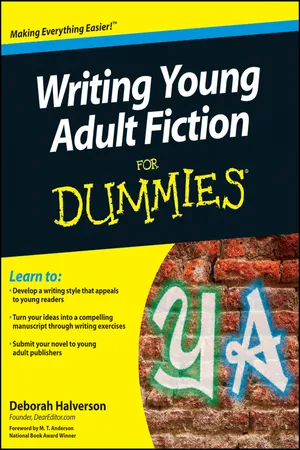Part I
Getting Ready to Write Young Adult Fiction
In this part . . .
Young adult fiction is as different from adult fiction as teenagers are from adults. It has its own rules, its own quirks, and its own very opinionated audience: teens.
Ultimately, the elements of storytelling are the same for both categories, but YA fiction writers must come at those elements with a different mindset. This part initiates you into that way of thinking. You find out what YA fiction is and how it constantly evolves, you discover the category’s core traits that defy change, you target specific age ranges and genres, you choose themes and conflicts that appeal to young readers, and you get yourself organized to write. Above all, you master the first steps in creating stories that resonate deeply with teens, a wonder-fully fickle, self-centered, sometimes reluctant, and ultimately fleeting readership who reads to define teens and their roles in the world — and who just plain loves a good story.
Chapter 1
The Lowdown on YA Fiction
In This Chapter
Understanding what YA fiction is and isn’t Exploiting YA’s unique opportunities Facing YA’s unique challenges Reaping the rewards of writing for young adults The Me Generation. Generation X. Generation Next. Each new crop of teens has its own culture and view of the world and their place in it. Their fiction — collectively called young adult fiction — shifts with the ebb and flow. This constant state of flux creates new opportunities for aspiring and veteran writers alike. Understanding YA fiction’s changing nature gives you insight into how you can fit into its future. This chapter offers a glimpse into its transitive nature while listing core traits that distinguish YA fiction despite its flux, along with the unique challenges and opportunities you face as a YA writer.
Introducing YA and Its Readers
Young adult fiction is distinguished by its youthful focus and appeal. The main characters are usually young adults (exceptions include the animal stars of Kathi Appelt’s The Underneath), and their stories, or narratives, reflect a youthful way of viewing the world that puts them at the center of everything. Characters act, judge, and react from that point of view until they mature through the events in the story.
One of the unique aspects of YA novels is that they have nearly universal appeal; YA fiction offers something for every interest and everyone who can read at a middle school level or higher. The audience includes young teens who fancy tales of first love and other relationships, older teens who can’t get enough of other teens’ troubles, and even grown-ups who like stories that help them remember what life was like when they thought they knew it all.
Knowing what makes a YA a YA
It’s easy to think that having a teen lead is what makes this fiction “young adult” fare. That matters, yes, but it’s not a defining factor on its own. Many adult books feature teenagers but have adult themes and exhibit adult sensibilities, sophistication, and awareness. Here are six traits that together help distinguish young adult fiction, all of which I talk about extensively in this book:
Teen-friendly casts: Teen novels star young adults with similarly aged peers who all exhibit youthful characterizations, or ways of thinking and behaving. These characters usually lack the empathy of an adult, worrying about how things affect them first and foremost. They don’t put themselves in others’ shoes well or readily, nor do they analyze why they or other people do things — at least not at the beginning of the story, before they’ve matured through their adventures. Adults are generally background characters or not present at all. (Chapter 5 gives you direction on writing characters that teens love.) Universal teen themes: The themes in young adult fiction are universal ones that real teens struggle with every day. The stories deal with issues and developmental hurdles that affect every generation, such as peer pressure and falling in love for the first time. (Flip to Chapter 2 for pointers on your theme.) Accessible narrative styles: The stories are structured with clarity, accessibility, and teen social culture in mind — perhaps with frequent paragraphing, lots of white space, short chapters, or structures that mimic journaling or electronic correspondence, such as texting or e-mail exchanges. All these style decisions depend on the intended audience’s specific age and sophistication level. Youthful narrative voice: The narrators’ choice of words and the sophistication of their views reflect the dramatic, often self-centered mindset of teens. Teen characters who narrate their own stories sound like real teens thanks to relaxed grammar and syntax and immature observations, whereas the adult or all-knowing (omniscient) narrators demonstrate an appreciation of how the teen mind works. Although first-person narration isn’t a requirement, it’s common enough to be called another helpful defining characteristic of YA fiction. (Chapter 9 helps you choose your narrator and have her tell the story from a teen’s unique point of view.) Moral centers: Young adult stories generally have moral centers, with their young characters growing and changing in a positive way. Even if the story does not have a happy ending, the story ends with the maturing of the main character, with that new wisdom being the positive factor. These novels avoid preaching, however, letting the story demonstrate the lesson while the readers interpret the “message” for themselves, which increases their sense of independence. You reveal this wisdom through your story’s plot. (Chapter 6 walks you through building a perfect plot.) Teen-friendly concepts: The themes may be universal, but the plots that embody those themes are unique and particularly intriguing to young adults. The events are believable within a teen’s experience ... 


